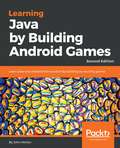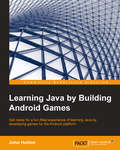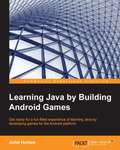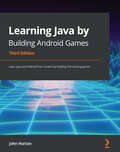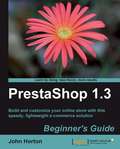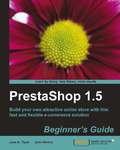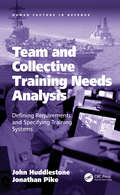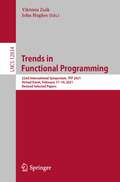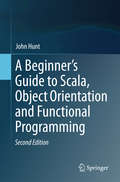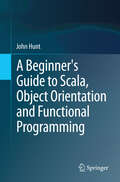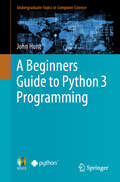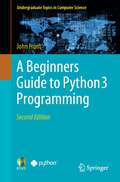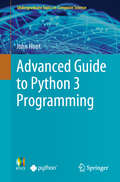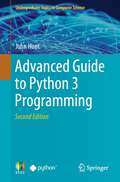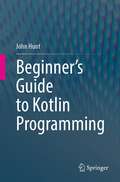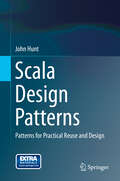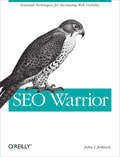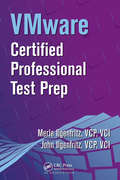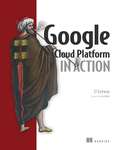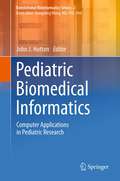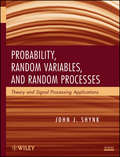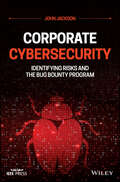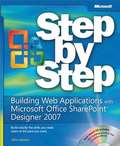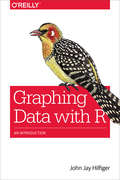- Table View
- List View
Learning Java by Building Android Games: Learn Java and Android from scratch by building six exciting games, 2nd Edition
by John HortonGet ready for a fun-filled experience of learning Java by developing games for the Android platformKey FeaturesLearn Java, Android, and object-oriented programming from scratchBuild games including Sub Hunter, Retro Pong, Bullet Hell, Classic Snake, and a 2D Scrolling ShooterCreate and design your own games, such as an open-world platform gameBook DescriptionAndroid is one of the most popular mobile operating systems presently. It uses the most popular programming language, Java, as the primary language for building apps of all types. However, this book is unlike other Android books in that it doesn’t assume that you already have Java proficiency.This new and expanded second edition of Learning Java by Building Android Games shows you how to start building Android games from scratch. The difficulty level will grow steadily as you explore key Java topics, such as variables, loops, methods, object oriented programming, and design patterns, including code and examples that are written for Java 9 and Android P. At each stage, you will put what you’ve learned into practice by developing a game. You will build games such as Minesweeper, Retro Pong, Bullet Hell, and Classic Snake and Scrolling Shooter games. In the later chapters, you will create a time-trial, open-world platform game. By the end of the book, you will not only have grasped Java and Android but will also have developed six cool games for the Android platform.What you will learnSet up a game development environment in Android StudioImplement screen locking, screen rotation, pixel graphics, and play sound effectsRespond to a player’s touch, and program intelligent enemies who challenge the player in different waysLearn game development concepts, such as collision detection, animating sprite sheets, simple tracking and following, AI, parallax backgrounds, and particle explosionsAnimate objects at 60 frames per second (FPS) and manage multiple independent objects using Object-Oriented Programming (OOP)Understand the essentials of game programming, such as design patterns, object-oriented programming, Singleton, strategy, and entity-component patternsLearn how to use the Android API, including Activity lifecycle, detecting version number, SoundPool API, Paint, Canvas, and Bitmap classes Build a side-scrolling shooter and an open world 2D platformer using advanced OOP concepts and programming patternsWho this book is forLearning Java by Building Android Games is for you if you are completely new to Java, Android, or game programming and want to make Android games. This book also acts as a refresher for those who already have experience of using Java on Android or any other platform without game development experience.
Learning Java by Building Android Games
by John HortonIf you are completely new to either Java, Android, or game programming and are aiming to publish Android games, then this book is for you. This book also acts as a refresher for those who already have experience in Java on another platforms or other object-oriented languages.
Learning Java by Building Android Games
by John Horton<P><P>Key Features <P><P>Acquaint yourself with Java and object-oriented programming, from zero previous experience <P><P>Build four cool games for your phone and tablet, from retro arcade-style games to memory and education games, and gain the knowledge to design and create your own games too <P><P>Walk through the fundamentals of building games and use that experience as a springboard to study advanced game development or just have fun <P><P>Book Description <P><P>Android is the fastest growing operating system (OS) with one of the largest installed bases of any mobile OS. Android uses one of the most popular programming languages, Java, as the primary language for building apps of all types. So, you should first obtain a solid grasp of the Java language and its foundation APIs to improve the chances of succeeding as an Android app developer. <P><P>This book will show you how to get your Android development environment set up and you will soon have your first working game. The difficulty level grows steadily with the introduction of key Java topics such as loops, methods, and OOP. You'll then use them in the development of games. You will learn how to build a math test game, a Simon-like memory game, a retro pong-style game, and for the grand finale, a Snake-style, retro arcade game with real Google Play leaderboards and achievements. The book has a hands-on approach and is packed with screenshots. <P><P>What You Will Learn <P><P>Set up an efficient, professional game development environment in Android Studio <P><P>Build your very own Android UI using easy to-use tools in Android Studio <P><P>Add real-time interaction with Java threads and implement locking/handling screen rotation, pixel graphics, clicks, animation, sound FX, and many other features in your games <P><P>Explore object-oriented programming (OOP) and design scalable, reliable, and well-written Java games or apps on almost any Android device <P><P>Build and deploy a graphical pong-style game using advanced OOP concepts <P><P>Explore APIs and implement advanced features such as online leaderboards and achievements using Google game services Make your game compelling to be the next big hit on Google Play market with a content update strategy and in-game marketing
Learning Java by Building Android Games: Learn Java and Android from scratch by building five exciting games, 3rd Edition
by John HortonGet ready to learn Java the fun way by developing games for the Android platform with this new and updated third editionKey FeaturesLearn Java, Android, and object-oriented programming from scratchFind out how to build games including Sub Hunter, Retro Pong, Bullet Hell, Classic Snake, and Scrolling ShootersCreate and design your own games by learning all the concepts that a game developer must knowBook DescriptionAndroid is one of the most popular mobile operating systems today. It uses the most popular programming language, Java, as one of the primary languages for building apps of all types. Unlike most other Android books, this book doesn't assume that you have any prior knowledge of Java programming, instead helps you get started with building Android games as a beginner. This new, improved, and updated third edition of Learning Java by Building Android Games helps you to build Android games from scratch. Once you've got to grips with the fundamentals, the difficulty level increases steadily as you explore key Java topics, such as variables, loops, methods, object-oriented programming (OOP), and design patterns while working with up-to-date code and supporting examples. At each stage, you'll be able to test your understanding by implementing the concepts that you've learned to develop a game. Toward the end, you'll build games such as Sub Hunter, Retro Pong, Bullet Hell, Classic Snake, and Scrolling Shooter. By the end of this Java book, you'll not only have a solid understanding of Java and Android basics but will also have developed five cool games for the Android platform.What you will learnSet up a game development environment in Android StudioRespond to a player's touch and program intelligent enemies who can challenge the player in different waysExplore collision detection, sprite sheets animation, simple tracking and following, AI, parallax backgrounds, and particle explosionsAnimate objects at 60 FPS and manage multiple independent objects using OOPWork with design patterns such as OOP, singleton, strategy, and entity-componentWork with the Android API, the SoundPool API, Paint, Canvas, Bitmap classes, and detect version numbersWho this book is forLearning Java by Building Android Games is for anyone who is new to Java, Android, or game programming and wants to develop Android games. The book will also serve as a refresher for those who already have experience using Java on Android or any other platform but are new to game development.
PrestaShop 1.3 Beginner's Guide
by John HortonThe book is structured so that following the chapters in order leads to building a fully functioning and live trading PrestaShop. Guidance is also given should you wish to learn or practice your skills in an offline, non-trading environment. Every chapter contains clearly structured and illustrated step-by-step explanation to achieve the goals discussed. Nothing is left for readers to work out themselves, but it would be very simple for them to use the information to go beyond the specific tutorials, should they wish to do so. There is optional additional reading, including more than a dozen specifically written downloadable e-books made available on the book's support website just for readers of PrestaShop 1.3 Beginners Guide. This book is for anybody who wants a fully functioning e-commerce store using PrestaShop. You do not have to have any previous knowledge of PrestaShop or any aspect of e-commerce or business in general. If you do, then you will probably find this guide really valuable as well. The book covers all you need to know about starting your own e-commerce business.
PrestaShop 1.5 Beginner’s Guide
by John Horton Jose A. TizonThis book is written in a friendly voice with lots of tips, tricks, and screenshots to help you set up, extend, and personalize your own online shop. If you want to start your own e-commerce business, then this book will help you do that.This book is for people who are interested in creating an online shop. Basic HTML and CSS skills would be beneficial but are not required as we will provide you with all the code and know-how you need.
Team and Collective Training Needs Analysis: Defining Requirements and Specifying Training Systems (Human Factors in Defence)
by Jonathan Pike John HuddlestoneMilitary capability is delivered operationally at a team and collective level, be it a unit as small as a squad or section, or as large as a maritime task group. Modern military forces are required to deal with a potentially wide range of missions frequently involving multiple alliance partners, within a geopolitical environment which can seem to change rapidly. Individual performance, while being important, is not the primary determinant of mission success - force integration, interoperability, adaptability and teamwork are key factors. Team and collective training which fully addresses these factors is fundamental to the development and delivery of military capability. As a consequence, the requirement to determine training requirements and specify effective systems for the delivery of team and collective training is critical to operational success. Training Needs Analysis (also known as Front End Analysis), is a well-established methodology for analysing training requirements and specifying training solutions used extensively by the UK and its NATO partners. However, the analytical techniques employed are optimised for individual training, with little guidance being offered on its application in the team and collective context. Team and Collective Training Needs Analysis (TCTNA) has been developed to close this methodological gap. It addresses the issues of the relationship of individual and team tasks, teamwork, command and control, task and training environments, scenario definition, instructional strategy, team training approaches, instructional functions, and wide-ranging organisational and procurement considerations. Part One of the book develops an integrated set of models which underpin the analytical approach presented in Part Two. Worked examples and case studies illustrate the application of the approach. Between 2005 and 2015 the authors worked on numerous training-related research projects at Cranfield University and Coventry University for the Human Factors Integration Defence Technology Centre and the Defence Human Capability Science and Technology Centre on behalf of the Defence Science and Technology Laboratory, UK Ministry of Defence.
Trends in Functional Programming: 22nd International Symposium, TFP 2021, Virtual Event, February 17–19, 2021, Revised Selected Papers (Lecture Notes in Computer Science #12834)
by John Hughes Viktória ZsókThis book constitutes revised selected papers from the 22nd International Symposium on Trends in Functional Programming, TFP 2021, which was held virtually in February 2020. The 6 full papers presented in this volume were carefully reviewed and selected from 18 submissions. They were organized in topical sections about nested parallelism, semantics, task-oriented programming and modelling, translating, proving functional programs. Chapter ‘Dataset Sensitive Autotuning of Multi-Versioned Code based on Monotonic Properties’ is available open access under a Creative Commons Attribution 4.0 International License via link.springer.com. Chapter ‘High-level Modelling for Typed Functional Programming’ is available open access under a Creative Commons Attribution 4.0 International License via link.springer.com.
A Beginner's Guide to Scala, Object Orientation and Functional Programming
by John HuntScala is now an established programming language developed by Martin Oderskey and his team at the EPFL. The name Scala is derived from Sca(lable) La(nguage). Scala is a multi-paradigm language, incorporating object oriented approaches with functional programming. Although some familiarity with standard computing concepts is assumed (such as the idea of compiling a program and executing this compiled from etc.) and with basic procedural language concepts (such as variables and allocation of values to these variables) the early chapters of the book do not assume any familiarity with object orientation nor with functional programming These chapters also step through other concepts with which the reader may not be familiar (such as list processing). From this background, the book provides a practical introduction to both object and functional approaches using Scala. These concepts are introduced through practical experience taking the reader beyond the level of the language syntax to the philosophy and practice of object oriented development and functional programming. Students and those actively involved in the software industry will find this comprehensive introduction to Scala invaluable.
A Beginner's Guide to Scala, Object Orientation and Functional Programming
by John HuntScala is a new programming language developed by Martin Odersky and his team at the EPFL. The name Scala is derived from Sca(lable) La(nguage). Scala is a multi-paradigm language, incorporating object oriented approaches with functional programming. Although some familiarity with standard computing concepts is assumed (such as the idea of compiling a program and executing this compiled form, etc.) and with basic procedural language concepts (such as variables and allocation of values to variables) the early chapters of the book do not assume any familiarity with object orientation nor functional programming. These chapters also step through other concepts with which the reader may not be familiar (such as list processing). From this background, John Hunt provides a practical introduction to object and functional technology using Scala, one of the newest and most interesting programming languages available. A variety of concepts are introduced through practical experience taking the reader beyond the level of the language syntax to the philosophy and practice of object-oriented development and functional programming. Students, and those actively involved in the software industry will find this comprehensive introduction to Scala and to object orientation and functional programming, invaluable.
A Beginners Guide to Python 3 Programming (Undergraduate Topics in Computer Science)
by John HuntThis textbook on Python 3 explains concepts such as variables and what they represent, how data is held in memory, how a for loop works and what a string is. It also introduces key concepts such as functions, modules and packages as well as object orientation and functional programming. Each section is prefaced with an introductory chapter, before continuing with how these ideas work in Python. Topics such as generators and coroutines are often misunderstood and these are explained in detail, whilst topics such as Referential Transparency, multiple inheritance and exception handling are presented using examples. A Beginners Guide to Python 3 Programming provides all you need to know about Python, with numerous examples provided throughout including several larger worked case studies illustrating the ideas presented in the previous chapters.
A Beginners Guide to Python 3 Programming (Undergraduate Topics in Computer Science)
by John HuntThis textbook is aimed at readers who have little or no knowledge of computer programming but want to learn to program in Python. It starts from the very basics including how to install your Python environment, how to write a very simple program and run it, what a variable is, what an if statement is, how iteration works using for and while loops as well as important key concepts such as functions, classes and modules. Each subject area is prefaced with an introductory chapter, before continuing with how these ideas work in Python. The second edition has been completely updated for the latest versions of Python including Python 3.11 and Python 3.12. New chapters have been added such as those that consider where and how Python is used, the use of Frozensets, how data can be sorted, enumerated types in Python, structural pattern matching and how (and why) Python Virtual Environments are configured. A new chapter ‘The Python Bites back’ is introduced to present the fourteen most common / biggest gotchas for someone new to Python. Other sections have been updated with new features such as Exception Groups, string operations and dictionary operations. A Beginners Guide to Python 3 Programming second Edition provides all you need to know about Python, with numerous examples provided throughout including several larger worked case studies illustrating the ideas presented in the previous chapters.
Advanced Guide to Python 3 Programming (Undergraduate Topics in Computer Science)
by John HuntAdvanced Guide to Python 3 Programming delves deeply into a host of subjects that you need to understand if you are to develop sophisticated real-world programs. Each topic is preceded by an introduction followed by more advanced topics, along with numerous examples, that take you to an advanced level. There are nine different sections within the book covering Computer Graphics (including GUIs), Games, Testing, File Input and Output, Databases Access, Logging, Concurrency and Parallelism, Reactive programming, and Networking. Each section is self-contained and can either be read on its own or as part of the book as a whole. This book is aimed at the those who have learnt the basics of the Python 3 language but want to delve deeper into Python’s eco system of additional libraries and modules, to explore concurrency and parallelism, to create impressive looking graphical interfaces, to work with databases and files and to provide professional logging facilities.
Advanced Guide to Python 3 Programming (Undergraduate Topics in Computer Science)
by John HuntAdvanced Guide to Python 3 Programming 2nd Edition delves deeply into a host of subjects that you need to understand if you are to develop sophisticated real-world programs. Each topic is preceded by an introduction followed by more advanced topics, along with numerous examples, that take you to an advanced level.This second edition has been significantly updated with two new sections on advanced Python language concepts and data analytics and machine learning. The GUI chapters have been rewritten to use the Tkinter UI library and a chapter on performance monitoring and profiling has been added. In total there are 18 new chapters, and all remaining chapters have been updated for the latest version of Python as well as for any of the libraries they use. There are eleven sections within the book covering Python Language Concepts, Computer Graphics (including GUIs), Games, Testing, File Input and Output, Databases Access, Logging, Concurrency and Parallelism, Reactive Programming, Networking and Data Analytics. Each section is self-contained and can either be read on its own or as part of the book as a whole. It is aimed at those who have learnt the basics of the Python 3 language but wish to delve deeper into Python’s eco system of additional libraries and modules.
Beginner's Guide to Kotlin Programming
by John HuntThis textbook assumes very little knowledge of programming so whether you have dabbled with a little JavaScript, played with a bit of Python, written Java or have virtually no programming experience at all you will find that it is for you.The first part of the book introduces Kotlin program structures as well as conditional flow of control features such as if and when expressions as well as iteration loops such as for, while and do-while. Subsequent chapters explain how functions are implemented in Kotlin and introduce concepts from functional programming such as higher order functions and curried functions.The second part focusses on object oriented programming techniques, these include classes, inheritance, abstraction and interfaces. The third part presents container data types such as Arrays, and collections including Lists, Sets and Maps and the fourth part considers concurrency and parallelism using Kotlin coroutines. The book concludes with an introduction to Android mobile application development using Kotlin.Clear steps are provided explaining how to set up your environment and get started writing your own Kotlin programs.An important aspect of the book is teaching by example and there are many examples presented throughout the chapters. These examples are supported by a public GitHub repository that provides complete working code as well as sample solutions to the chapter exercises. This helps illustrate how to write well structured, clear, idiomatic Kotlin to build real applications.
Scala Design Patterns
by John HuntScala is a new and exciting programming language that is a hybrid between object oriented languages such as Java and functional languages such as Haskell. As such it has its own programming idioms and development styles. Scala Design Patterns looks at how code reuse can be successfully achieved in Scala. A major aspect of this is the reinterpretation of the original Gang of Four design patterns in terms of Scala and its language structures (that is the use of Traits, Classes, Objects and Functions). It includes an exploration of functional design patterns and considers how these can be interpreted in Scala's uniquely hybrid style. A key aspect of the book is the many code examples that accompany each design pattern, allowing the reader to understand not just the design pattern but also to explore powerful and flexible Scala language features. Including numerous source code examples, this book will be of value to professionals and practitioners working in the field of software engineering.
SEO Warrior: Essential Techniques for Increasing Web Visibility (Animal Guide)
by John I JerkovicHow can you make it easier for people to find your website? And how can you convert casual visitors into active users? SEO Warrior shows you how it's done through a collection of tried and true techniques, hacks, and best practices. Learn the nuts and bolts of search engine optimization (SEO) theory, the importance of keyword strategy, and how to avoid and remedy search engine traps.You'll also learn about search engine marketing (SEM) practices, such as Google AdWords, and how you can use social networking to increase your visibility. Ideal for web developers, savvy marketers, webmasters, and anyone else interested in SEO, this book serves not only as an SEO tutorial, but also as a reference for implementing effective SEO techniques.Create compelling sites with SEO that can stand the test of timeOptimize your site for Google, Yahoo!, Microsoft's Bing, as well as search engines used in different parts of the worldConduct keyword research to find the best terms to reach your audience--and the related terms they'll respond toLearn what makes search engines tick by utilizing custom scriptsAnalyze your site to see how it measures up to the competition
VMware Certified Professional Test Prep
by Merle Ilgenfritz John IlgenfritzWritten by VM-certified instructors with years of professional and teaching experience, VMware Certified Professional Test Prep is the ultimate guide to the VCP exam. Its organized and highly practical approach will help administrators successfully complete the exam while also maximizing their ability to apply this tool on the job. The guide covers the body of knowledge required of a VMware certified professional, provides the tools needed to keep that knowledge current, and helps develop the wherewithal to apply that knowledge to real solutions. Covering the ESX 3.0.x through ESX 3.5.x releases that are the focus of the VCP test, this volume: Reproduces many of the real-world examples that have proven very helpful to students in the authors' classrooms Applies step-by-step instructions to more than 700 software screenshots, providing a virtual hands-on experience Points to Web resources that will keep the reader current with the latest advances Includes logistical information on the test, including costs and class location Covers background information on various topics such as storage and networking to provide a complete understanding on the implementation of a VMWare VI3 solution Provides questions at the end of the chapters that cover the important concepts Also of great use to those administrators who have already received their certification, this book includes solutions to many of the common gotchas that they are certain to encounter in virtual environments. In particular, capacity-planning concepts reveal the specific details needed to make full use of VMware's unique resource management capabilities. Troubleshooting tips appear throughout the book, making it a useful resource in the virtualized datacenter.
Google Cloud Platform in Action
by John J. GeewaxSummaryGoogle Cloud Platform in Action teaches you to build and launch applications that scale, leveraging the many services on GCP to move faster than ever. You'll learn how to choose exactly the services that best suit your needs, and you'll be able to build applications that run on Google Cloud Platform and start more quickly, suffer fewer disasters, and require less maintenance.Purchase of the print book includes a free eBook in PDF, Kindle, and ePub formats from Manning Publications.About the TechnologyThousands of developers worldwide trust Google Cloud Platform, and for good reason. With GCP, you can host your applications on the same infrastructure that powers Search, Maps, and the other Google tools you use daily. You get rock-solid reliability, an incredible array of prebuilt services, and a cost-effective, pay-only-for-what-you-use model. This book gets you started.About the BookGoogle Cloud Platform in Action teaches you how to deploy scalable cloud applications on GCP. Author and Google software engineer JJ Geewax is your guide as you try everything from hosting a simple WordPress web app to commanding cloud-based AI services for computer vision and natural language processing. Along the way, you'll discover how to maximize cloud-based data storage, roll out serverless applications with Cloud Functions, and manage containers with Kubernetes. Broad, deep, and complete, this authoritative book has everything you need.What's insideThe many varieties of cloud storage and computingHow to make cost-effective choicesHands-on code examplesCloud-based machine learningAbout the ReaderWritten for intermediate developers. No prior cloud or GCP experience required.About the AuthorJJ Geewax is a software engineer at Google, focusing on Google Cloud Platform and API design.Table of ContentsPART 1 - GETTING STARTED What is "cloud"? Trying it out: deploying WordPress on Google Cloud The cloud data center PART 2 - STORAGE Cloud SQL: managed relational storage Cloud Datastore: document storage Cloud Spanner: large-scale SQL Cloud Bigtable: large-scale structured data Cloud Storage: object storage PART 3 - COMPUTINGCompute Engine: virtual machines Kubernetes Engine: managed Kubernetes clusters App Engine: fully managed applications Cloud Functions: serverless applications Cloud DNS: managed DNS hosting PART 4 - MACHINE LEARNINGCloud Vision: image recognition Cloud Natural Language: text analysis Cloud Speech: audio-to-text conversion Cloud Translation: multilanguage machine translation Cloud Machine Learning Engine: managed machine learning PART 5 - DATA PROCESSING AND ANALYTICSBigQuery: highly scalable data warehouse Cloud Dataflow: large-scale data processing Cloud Pub/Sub: managed event publishing
Pediatric Biomedical Informatics
by John J. HuttonAdvances in the biomedical sciences, especially genomics, proteomics, and metabolomics, taken together with the expanding use of electronic health records, are radically changing the IT infrastructure and software applications needed to support the transfer of knowledge from bench to bedside. Pediatric Biomedical Informatics: Computer Applications in Pediatric Research describes the core resources in informatics necessary to support biomedical research programs and how these can best be integrated with hospital systems to receive clinical information that is necessary to conduct translational research.The focus is on the authors' recent practical experiences in establishing an informatics infrastructure in a large research-intensive children's hospital. This book is intended for translational researchers and informaticians in pediatrics, but can also serve as a guide to all institutions facing the challenges of developing and strengthening informatics support for biomedical research. The first section of the book discusses important technical challenges underlying computer-based pediatric research, while subsequent sections discuss informatics applications that support biobanking and a broad range of research programs. Pediatric Biomedical Informatics provides practical insights into the design, implementation, and utilization of informatics infrastructures to optimize care and research to benefit children. Dr. John Hutton is the Vice President and Director of Biomedical Informatics at Cincinnati Children's Hospital Medical Center, Cincinnati, OH, USA. He is also Professor of Pediatrics and Associate Dean for Information Services at the University of Cincinnati College of Medicine.
Probability, Random Variables, and Random Processes
by John J. ShynkProbability, Random Variables, and Random Processes is a comprehensive textbook on probability theory for engineers that provides a more rigorous mathematical framework than is usually encountered in undergraduate courses. It is intended for first-year graduate students who have some familiarity with probability and random variables, though not necessarily of random processes and systems that operate on random signals. It is also appropriate for advanced undergraduate students who have a strong mathematical background.The book has the following features:Several appendices include related material on integration, important inequalities and identities, frequency-domain transforms, and linear algebra. These topics have been included so that the book is relatively self-contained. One appendix contains an extensive summary of 33 random variables and their properties such as moments, characteristic functions, and entropy.Unlike most books on probability, numerous figures have been included to clarify and expand upon important points. Over 600 illustrations and MATLAB plots have been designed to reinforce the material and illustrate the various characterizations and properties of random quantities.Sufficient statistics are covered in detail, as is their connection to parameter estimation techniques. These include classical Bayesian estimation and several optimality criteria: mean-square error, mean-absolute error, maximum likelihood, method of moments, and least squares.The last four chapters provide an introduction to several topics usually studied in subsequent engineering courses: communication systems and information theory; optimal filtering (Wiener and Kalman); adaptive filtering (FIR and IIR); and antenna beamforming, channel equalization, and direction finding. This material is available electronically at the companion website.Probability, Random Variables, and Random Processes is the only textbook on probability for engineers that includes relevant background material, provides extensive summaries of key results, and extends various statistical techniques to a range of applications in signal processing.
How Healthcare Data Privacy Is Almost Dead ... and What Can Be Done to Revive It!
by John J. Trinckes, Jr.The healthcare industry is under privacy attack. The book discusses the issues from the healthcare organization and individual perspectives. Someone hacking into a medical device and changing it is life-threatening. Personal information is available on the black market. And there are increased medical costs, erroneous medical record data that could lead to wrong diagnoses, insurance companies or the government data-mining healthcare information to formulate a medical ‘FICO’ score that could lead to increased insurance costs or restrictions of insurance. Experts discuss these issues and provide solutions and recommendations so that we can change course before a Healthcare Armageddon occurs.
Corporate Cybersecurity: Identifying Risks and the Bug Bounty Program
by John JacksonAn insider’s guide showing companies how to spot and remedy vulnerabilities in their security programs A bug bounty program is offered by organizations for people to receive recognition and compensation for reporting bugs, especially those pertaining to security exploits and vulnerabilities. Corporate Cybersecurity gives cyber and application security engineers (who may have little or no experience with a bounty program) a hands-on guide for creating or managing an effective bug bounty program. Written by a cyber security expert, the book is filled with the information, guidelines, and tools that engineers can adopt to sharpen their skills and become knowledgeable in researching, configuring, and managing bug bounty programs. This book addresses the technical aspect of tooling and managing a bug bounty program and discusses common issues that engineers may run into on a daily basis. The author includes information on the often-overlooked communication and follow-through approaches of effective management. Corporate Cybersecurity provides a much-needed resource on how companies identify and solve weaknesses in their security program. This important book: Contains a much-needed guide aimed at cyber and application security engineers Presents a unique defensive guide for understanding and resolving security vulnerabilities Encourages research, configuring, and managing programs from the corporate perspective Topics covered include bug bounty overview; program set-up; vulnerability reports and disclosure; development and application Security Collaboration; understanding safe harbor and SLA Written for professionals working in the application and cyber security arena, Corporate Cybersecurity offers a comprehensive resource for building and maintaining an effective bug bounty program.
Building Web Applications with Microsoft® Office SharePoint® Designer 2007 Step by Step
by John JansenTeach yourself how to create rich, dynamic Web applications with Microsoft Office SharePoint Designer 2007. Master the tools for managing user input and backend processes--without coding--and deliver the smart solutions your business needs. Use CSS to customize layout and optimize usability Build your navigation structure Create, access, and link data sources Manipulate data views with SharePoint and ASP.NET controls Enable dynamic rendering and interactivity Use Windows Workflow Foundation Know what's going on behind the scenes--so you make the best choices Your all-in-one learning experience includes: Files for building skills and practicing the book's lessons Fully searchable eBook Windows Vista Product Guide eReference--plus other resources--on CD A Note Regarding the CD or DVD The print version of this book ships with a CD or DVD. For those customers purchasing one of the digital formats in which this book is available, we are pleased to offer the CD/DVD content as a free download via O'Reilly Media's Digital Distribution services. To download this content, please visit O'Reilly's web site, search for the title of this book to find its catalog page, and click on the link below the cover image (Examples, Companion Content, or Practice Files). Note that while we provide as much of the media content as we are able via free download, we are sometimes limited by licensing restrictions. Please direct any questions or concerns to booktech@oreilly.com.
Graphing Data with R: An Introduction
by John Jay HilfigerIt’s much easier to grasp complex data relationships with a graph than by scanning numbers in a spreadsheet. This introductory guide shows you how to use the R language to create a variety of useful graphs for visualizing and analyzing complex data for science, business, media, and many other fields. You’ll learn methods for highlighting important relationships and trends, reducing data to simpler forms, and emphasizing key numbers at a glance.Anyone who wants to analyze data will find something useful here—even if you don’t have a background in mathematics, statistics, or computer programming. If you want to examine data related to your work, this book is the ideal way to start.Get started with R by learning basic commandsBuild single variable graphs, such as dot and pie charts, box plots, and histogramsExplore the relationship between two quantitative variables with scatter plots, high-density plots, and other techniquesUse scatterplot matrices, 3D plots, clustering, heat maps, and other graphs to visualize relationships among three or more variables
